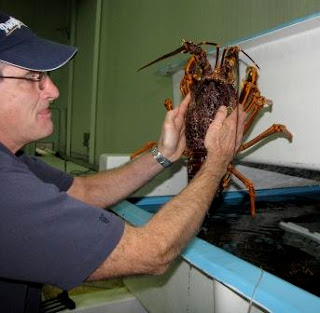Just off the coast of Japan,
Kouichi Mura looks out at the ocean. He’s not just observing the water, but he’s watching the height & direction of the waves, the level of the tide, the speed of the current, and feels the wind and rain on his face. He does this because he’s a fisherman.
Mura learned fishing and the ocean from his parents, his father was a fisherman and mother was the
on board assistant. When
Mura was 1 month old, he went on his first fishing trip. He grew up wanting to be a fisherman and concerned with the preservation of the fish that he catches. I wonder if other fishermen feel the same?
 Mura
Mura is that special breed of fisherman; his catch
isn’t found at
Tsukiji Fish Market, the biggest wholesale fish and seafood market in the world. His Suzuki (Japanese Sea bass) is highly-prized by many top chefs and restaurants and commands a higher price than other Suzuki. His fish are caught in areas where the seas are rough and the currents strong, not many fishermen go to these areas because of the harsh conditions, but
Mura knows this area like the back of his hand. For
Mura, these harsh conditions make for a stronger and tastier Suzuki.
Mura’s handling of the fish is a branded practice and very unique. His secret, he uses an air compressor when he preps his prized catch, something he developed on his own.
Mura doesn’t give his catch the added stress when they’re caught. He keeps them alive in a tank aboard his boat and covers the tank at night with a blanket. A fish with less stress taste better and is why he can command a higher price from top chefs. Common sense says to consume fresh fish right away, but the way that
Mura handles and prepares his fish, its best on the 3rd day. Even when his fish are shipped to restaurants in Tokyo, he carefully packs them with just enough ice to keep them at an optimal temperature and humidity.
 Mura
Mura talks to chefs and restaurant owners and explains his methods. His prized catch can be found at many Michelin 3 star restaurants in Tokyo, like French restaurant, Restaurant
Quintessens.
Sukiyabashi Jiro, is arguably the highest rated sushi bar in Tokyo and a Michelin 3 Star restaurant. They wanted to try this prized Suzuki, the chef
hasn’t used a good Suzuki in 20 years was amazed at the sweetness of
Mura’s sea bass.
He’s a protector of the sea and its creatures, but understands the conservation of the fish that he catches; he only catches what he needs to put food on his table for his family. If he catches too much fish, the quality goes down. There needs to be a delicate balance in the ocean; well, I guess in our lives too. There are fishermen who care about preservation and how fish are treated.
Mura said if he was a fish, he would be lucky to be caught by a fisherman like himself.
It’s good to know that there are still people out there who do it the right way… Let’s continue to eat sushi, One Fish at a time.
UMI thanks you for your continued support.
 The Sushi Bar was a popular booth at the festival
The Sushi Bar was a popular booth at the festival






























